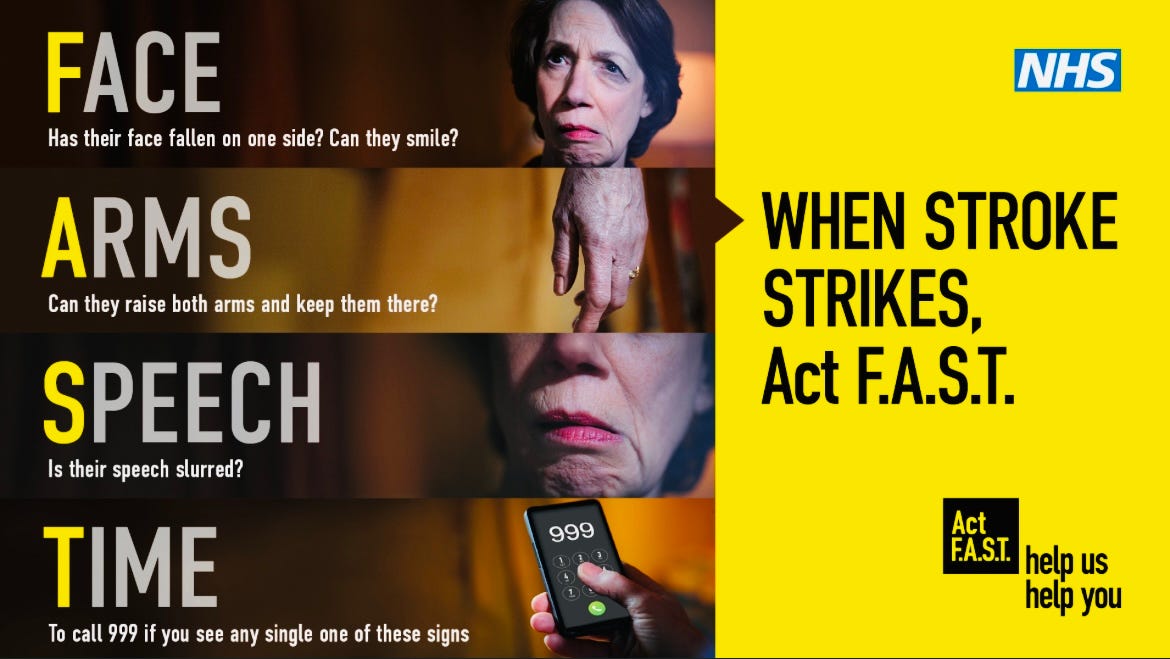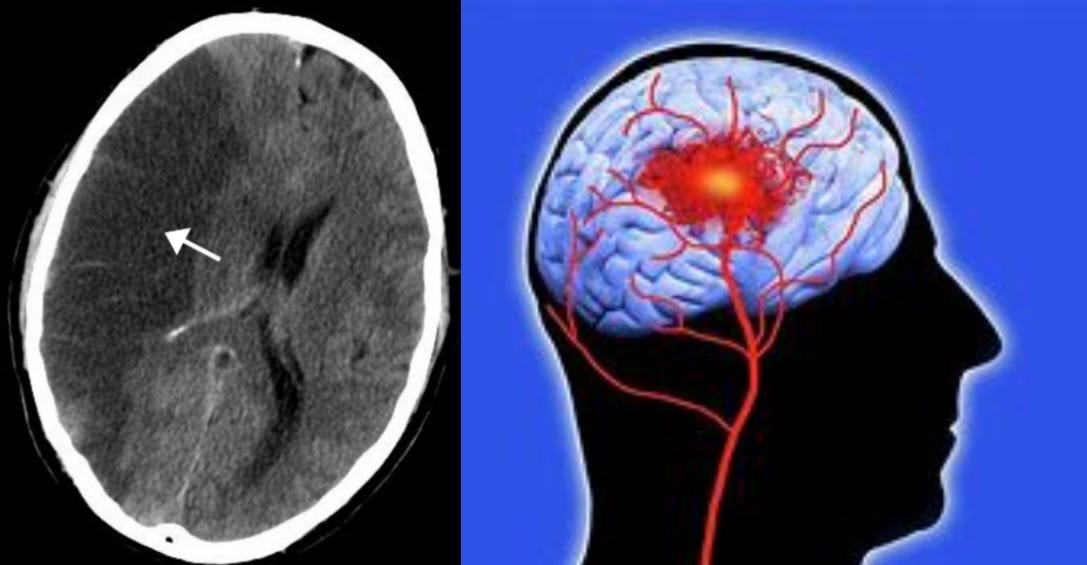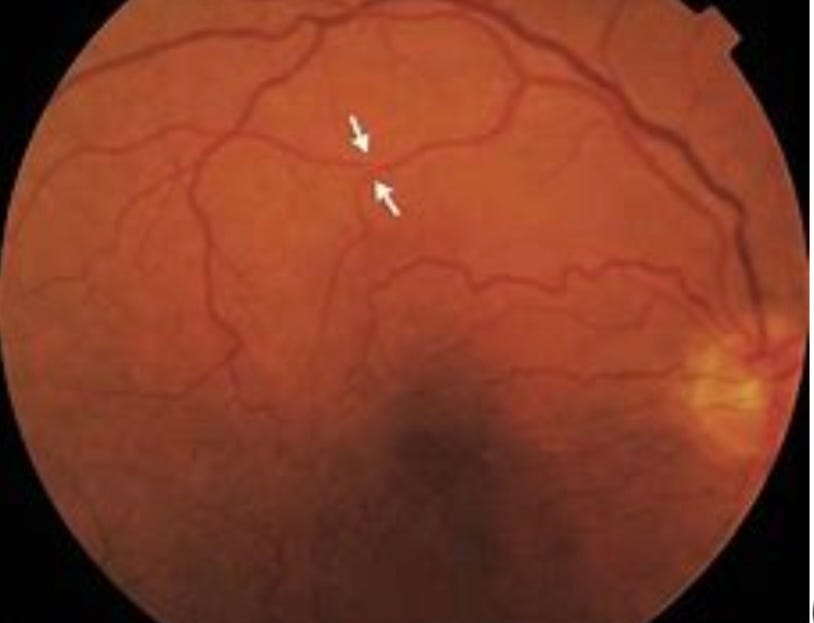The different types of stroke: How to spot the symptoms & signs of rarer presentations.
As we are all aware from NHS campaigns acting ‘FAST’ improves treatment and recovery and it is well publicised as per graphic below the facial droop, speech changes and weakness in motor function on one side are the commonly publicised symptom presentation of strokes, but sometimes strokes can present with a variety of other symptoms. The purpose of this article is to inform you of those other less common symptoms for awareness rather than expectation of eliciting the signs before medical help is summoned.
As per the NHS website a stroke or ‘cerebro-vascular accident’ (CVA), is defined as follows:
‘A stroke is when blood stops flowing to a part of your brain. It can affect things like speech and movement, and take a long time to recover. A stroke needs urgent medical help in hospital because it can be life-threatening’ (1).
Strokes can be due to blockages or cholesterol plaques detaching from a major artery in the neck (carotid) or an issue with the heart (e.g. arrhythmia generating a clot or valvular/immobile myocardium, and even blood issues related to increased propensity to forming clots. Nearly 90% of strokes are from thromboembolic events as described above (2). Risk factors for strokes of this type include: high blood pressure, high cholesterol, smoking, obesity, diabetes and high alcohol intake. USA data suggests someone has a stroke every 40 seconds and someone dies of a stroke every 3.5 minutes (2).
However, there is a different type of stroke known as a haemorrhagic (or bleed) type phenomenon which accounts for 10% of incidences and are managed differently. Risk factors leading to a ruptured blood vessel in the brain are commonly high blood pressure, a buildup of a protein called “amyloid” in your arteries (cerebral amyloid angiopathy), high LDL cholesterol or triglycerides, smoking, chronic liver disease, undergoing dual antiplatelet therapy, misuse of drugs (e.g. cocaine heroin and amphetamines), older age and brain tumour patients (2).
Transient ischaemic attacks
When permanent neurological disability is present this is termed a stroke. A temporary and reversible neurology caused by small clots/debris is termed a ‘transient ischaemic attack’ and is defined by the NHS as: ‘A transient ischaemic attack (TIA) or "mini stroke" is caused by a temporary disruption in the blood supply to part of the brain. The disruption in blood supply results in a lack of oxygen to the brain. This can cause sudden symptoms similar to a stroke, such as speech and visual disturbance, and numbness or weakness in the face, arms and legs. But a TIA does not last as long as a stroke. The effects last a few minutes to a few hours and fully resolve within 24 hours (3).
RARE STROKE TYPES AND HOW TO SPOT THE SYMPTOMS:
Amaurosis Fugax
This phenomenon is defined as: ‘Amaurosis fugax refers to an attack of transient and painless loss of vision in one eye. It is a common clinical symptom indicative of transient retinal (back of eye) ischaemia, usually associated with narrowing of the carotid artery (on the same side as affected eye) or emboli (cardiac and aortic). It is often described as a curtain passing across the eye’ (4)
(5)
The cerebellar stroke.
A cerebellar stroke occurs when ‘there is a disruption of blood flow to the cerebellum, which is the part of the brain responsible for coordination and balance. This type of stroke is relatively rare, accounting for 2-3% of all stroke cases. Symptoms may include dizziness, difficulty walking, and coordination problems. (6)
These strokes do not present with the typical FAST positive clinical signs and one of the main purposes of this substack is to show you how to spot these clinical symptoms and signs. At medical school you are taught an acronym which is DANISHPR which covers the following 8 common symptoms of a cerebellar stroke which as previously stated accounts for more than 1/50 strokes.
• Dysdiadochokinesia
• Ataxia (gait and posture)
• Nystagmus
• Intention tremor
• Slurred, staccato speech
• Hypotonia/heel-shin test
• Past pointing
• Rombergs sign.
1) Dysdiadochokinesia
Dysdiadochokinesia is the medical term used to describe difficulty performing quick and alternating movements, usually by opposing muscle groups. It involves asking the patient to tap the palm of one hand with the fingers of the other, then rapidly turn over the fingers and tap the palm with the back of them, repeatedly.
Please find a video link of an example of this sign:
2) Ataxia of gait and posture
People with ataxia have problems with coordination and balance. Often people notice a problem when they realisethey’ve been falling over more than usual, struggling to walk in a straight line or have become more clumsy. People tend to walk with a staggering wide based gait or swaying posture as if drunk.
Please find a video link of an example of this sign:
3) Nystagmus
Nystagmus is rapid, uncontrollable eye movements. If you have nystagmus, your eyes may move up and down, side to side or in a circular motion (7).
Please find a video link of an example of this sign:
4) Intention tremor
Intention tremor describes a tremor which is worse during voluntary movement.
Intention tremor is best seen by asking the patient to touch first their nose, then the examiner's finger, which should be held such that the patient has to nearly fully stretch their arm to touch it (8).
Please find a video link of an example of this sign:
5) Slurred speech.
Pretty self explanatory. However speech can not only be slurred it can be jumbled and also delayed ability to ‘get words out’ what we term ‘expressive dysphasia’.
(6) Hypotonia/Heel shin test:
Hypotonia is a condition characterised by low muscle toneoften involving reduced muscle strength.
Please find a video link of an example of this sign:
The heel-to-shin test is a neurological examination used to assess coordination and gait often disrupted in cerebellar strokes. It involves patient moving their heel up and down along the opposite shin in a smooth, controlled manner, which tests the coordination of the lower extremities.
Please find a video link of an example of this sign:
6) Past pointing
In essence, past pointing is a specific sign observed in the finger-nose test, indicating a possible neurological issue related to the cerebellum.
7) Rombergs sign/test
A Romberg test (also known as Romberg’s sign) is a simple physical test to see if you have
The key to this article was to recognise symptoms of stroke that are not the commonly discussed FAST positive symptoms and to raise awareness of the other types of presentations of rarer types of stroke and what the symptoms and signs look like when demonstrated. The message is the same. Time is extremely important and while informing you of these other presenting features if anyone has any of them continue to follow the message of FAST. Time really does save brain and subsequent disability so please don’t conduct a full OSCE type medical assessment if you feel these signs are present call 999 and ask for help.
References
(1) https://www.nhs.uk/conditions/stroke/
(2) https://www.healthline.com/health/stroke/ischemic-vs-hemorrhagic-stroke#ischemic-stroke
(3) https://www.nhs.uk/conditions/transient-ischaemic-attack-tia/
(4) https://gpnotebook.com/pages/neurology/amaurosis-fugax
(5) https://healthjade.com/amaurosis-fugax/
(6) https://www.healthline.com/health/cerebellar-stroke
(7) https://my.clevelandclinic.org/health/diseases/22064-nystagmus
(8) https://gpnotebook.com/en-GB/pages/neurology/intention-tremor
(9) https://my.clevelandclinic.org/health/diagnostics/22901-romberg-test







It would be worth adding mRNA & DNA vaccines to your list of risk factors for either thrombotic or haemorrhagic strokes. Also shouldn't vaccination history be a routine part of the drug history?
Thank you, Dr. - most useful.